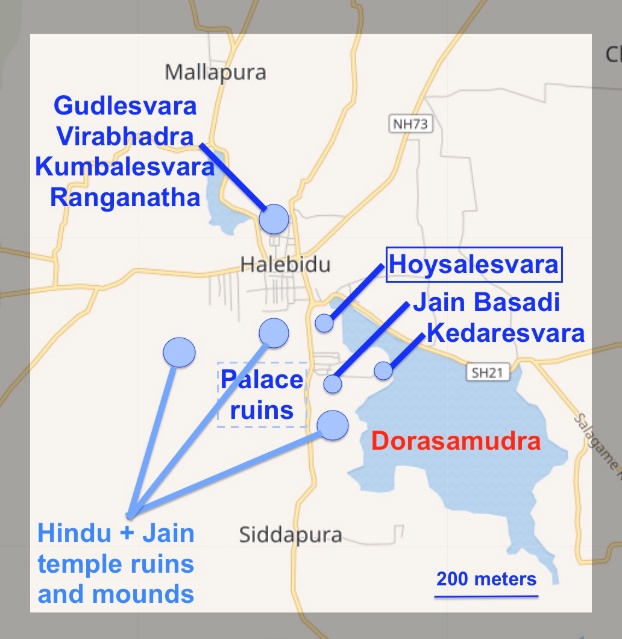Halebidu and Its Temples- Hoysaleshwara & Belur Halebidu Temple
Halebidu
Halebidu is a city located in the Hassan District of Karnataka, India, is a gem for those intrigued, artwork, and structure. Once the regal capital of the Hoysala Empire in the 12th century, Halebidu, which means ‘Old city’, is renowned for its extraordinary temples, with the Hoysaleshwara and Belur Halebidu temples status as testaments to the architectural prowess of the Hoysala era.
The city was destroyed by the repeated invasion of the Delhi Sultanate ‒ in 1311 by Malik Kafur, the military general of Ala-ud-din Khilji and in 1327 by Muhammad-bin-Tughlaq.
Historically, it has been known by the name Dwarasamudram. It was the capital of the Hoysala empire which ruled the region between 1050 CE to 1355 CE. Initially, they ruled from Belur, but Vishnuvardhana built a new capital at Halebidu anew near a large reservoir.
Halebidu is remarkable for the Hindu and Jain temples built in Hoysala architecture.
- Hoysaleshwara Temple
- Belur Halebidu Temple
- Kedareshwara Temple
- Jain Basadi temples

Fig (Source: Wikipedia)
The Hoysaleshwara Temple
At the heart of Halebidu’s historic landscape is the Hoysaleshwara Temple, a masterpiece dedicated to Lord Shiva. This temple is an epitome of Hoysala architecture, famed for its complex carvings and detailed sculptures that tell stories of historic Hindu mythology and the Hoysala Empire’s grandeur. Built in the 12th century, it took nearly 3 decades to complete, showcasing the determination and skill of its creators.

Architectural Brilliance
The temple is renowned for its stunningly detailed carvings that cover every inch of the exterior walls. The sculptures depict scenes from the epic tales of Mahabharata and Ramayana, alongside figures of gods, goddesses, and mythological creatures. What makes the Hoysaleshwara Temple stand out is its use of soapstone, a material that allows for intricate detailing, which has withstood the ravages of time, maintaining the artistry for future generations.
Symbolism and Design
The temple’s design is symbolic, presenting two large sanctums devoted to Hoysaleshwara and Shantaleshwara, named after the temple’s patron, King Vishnuvardhana Hoysaleswara, and his wife, Queen Shantala Devi. Unlike traditional temple layouts, it does not follow a rigid geometric pattern, instead offering a completely unique asymmetrical design that adds to its attraction.
Belur Halebidu Temple
A little farther away from Halebidu is its sister monument Chennakesava temple at Belur, which is often referred to in conjuction with Halebidu due to their historical and architectural importance. This temple is also a creation from the Hoysala period is dedicated to Lord Vishnu and stands as another prime example of fine art that at that time.
Beauty and Cultural Meaning
The Belur temple is known for its magnificent sculptures and detailed friezes that encapsulate the essence of Hoysala art. The facade of the Temple is decorated with intricate carvings, each telling a different story. The gravity-defying architecture and harmonious blend of art, religion and science reflect the advanced cultural sophistication of the Hoysala Empire.
Halebidu Journey
Halebidu and its temples are accessible throughout the year for travelers and history enthusiats planning to visit. However, the winter months from October to March are considered ideal due to the pleasant weather. While there, visitors can participate in guided tours available in multiple languages, to introduce them to the history and architectural significance of these sites.
conclusion
Halebidu, with its historical depth and architectural marvels like the Hoysaleshwar Belur and Halebidu temples, serves as a window into the past, offering glimpse of the artistic and cultural legacy of the Hiysala Empire. For those who wish to journey through time and explore the legacy of ancient Indian Architecture and mythology. Halebidu is a destination that promises an unforgettable experience
In the end, Halebidu is not just a location on the map; it is a narrative of artistic, mastery, devotion and the enduring spirit of human creativity, inviting explorers form across the globe to witness its timeless beauty.
Also Read: Hoysala Dynasty



![Panchayatana Style Of Temple Architecture [Complete Upsc Notes] | Updated November 22, 2025 Panchayatana Style Of Temple Architecture [Complete Upsc Notes]](https://www.99notes.in/wp-content/uploads/2023/03/panchayatan-style-99notes-upsc-768x512.webp)


